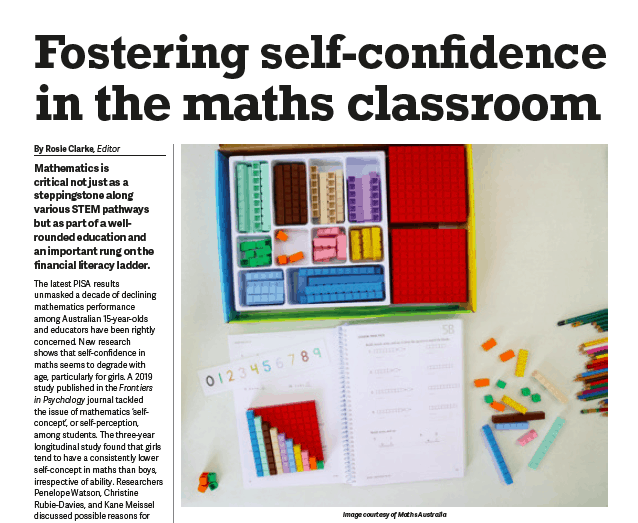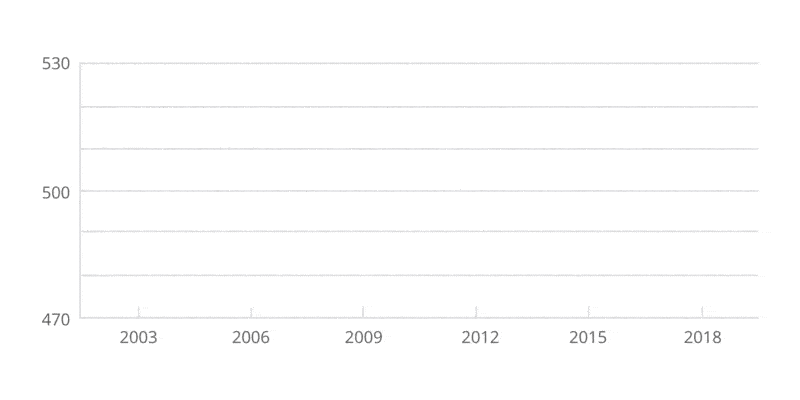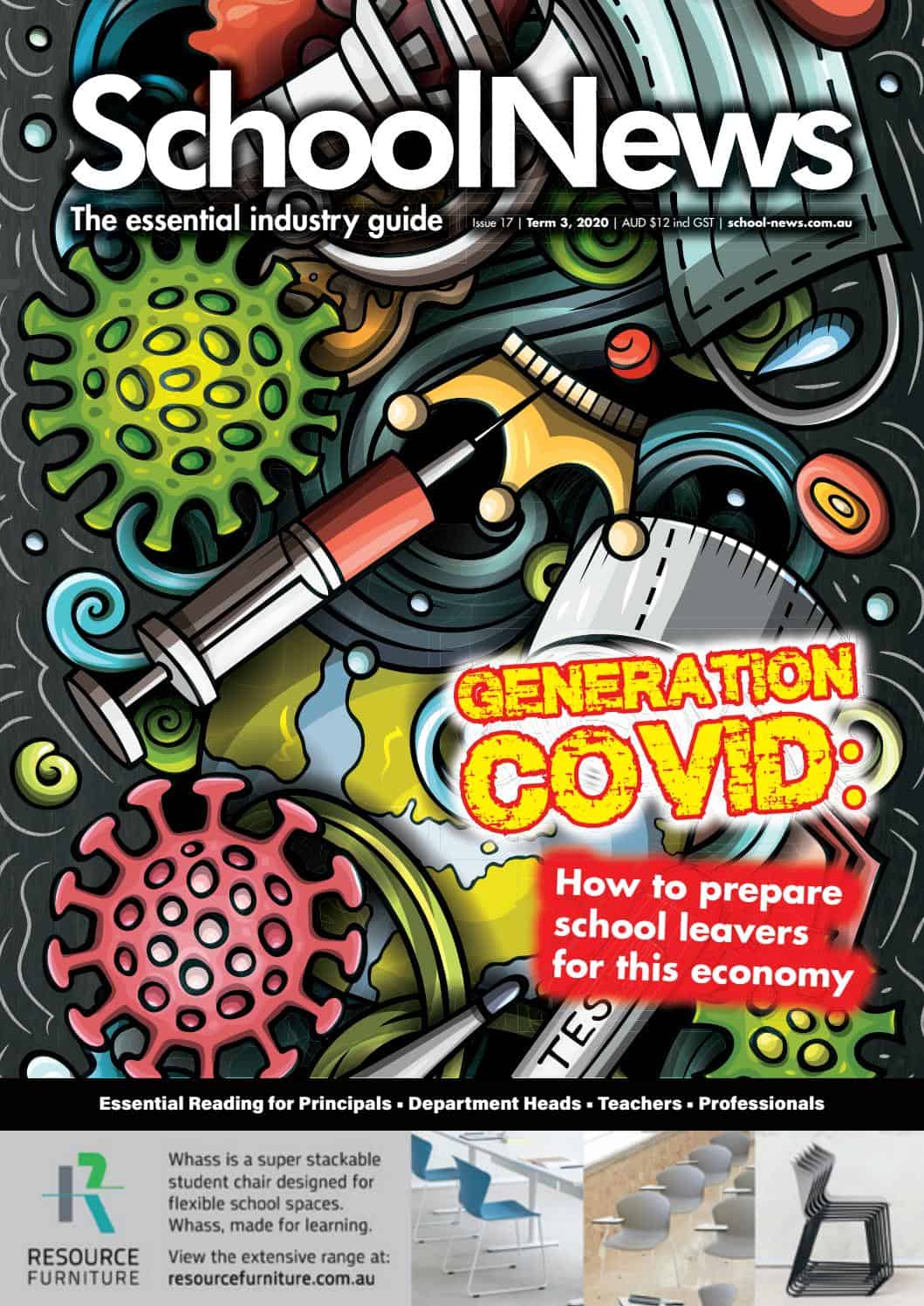
Fostering Self-confidence in the Maths classroom
School News reported the need for effective maths instruction in order to provide well-rounded education to students, especially after COVID restrictions and lockdowns. The implications and upsets caused by the pandemic have affected the learning journey of many students, and mostly not in a good way.
How do teachers handle students in the classroom post-COVID? Rosie Clarke, editor of School News, interviewed Esther White about specific strategies to help with classroom management and the importance of using multisensory tools to achieve those results.
What impact does mathematics have for students?
Mathematics is critical not just as a steppingstone along various STEM pathways but as part of a well- rounded education and an important rung on the financial literacy ladder.
The latest PISA results unmasked a decade of declining mathematics performance among Australian 15-year-olds and educators have been rightly concerned. New research shows that self-confidence in maths seems to degrade with age, particularly for girls. A 2019 study published in the Frontiers in Psychology Journal tackled the issue of mathematics ‘self- concept’, or self-perception, among students. The three-year longitudinal study found that girls tend to have a consistently lower self-concept in maths than boys, irrespective of ability. Researchers Penelope Watson, Christine Rubie-Davies, and Kane Meissel discussed possible reasons for this, noting that social comparison and teacher expectations hold a lot of influence.
They established that learner agency can help mitigate these trends in the classroom, and positive outcomes were associated with pedagogy that prioritises collaboration over
competition in the classroom; self- chosen activities, buddy systems, and mixed ability groups to help discourage social comparison, where students may otherwise compare themselves to their peers. Encouraging a supportive classroom environment is key to boosting a positive self-image in maths but the study also highlighted value in teachers having high expectations for all students, rather than reinforcing stereotypes about mathematics potential for girls or students of diverse cultural heritage.
What are PISA results?
PISA, the Programme for International Student Assessment (PISA) is a worldwide study by the Organisation for Economic Co-operation and Development (OECD) intended to evaluate educational systems by measuring 15-year-old school pupils' scholastic performance on mathematics, science, and reading. It was first performed in 2000 and then repeated every three years. It's aim is to provide comparable data with a view to enabling countries to improve their education policies and outcomes.
Each year, Australian school students sit the PISA exam. But what most results are indicating, especially in the past few years and has the education department very concerned, is a rapid decline in numerical understanding.
PISA maths results for Australian students are plummeting:

How can teachers re-ignite confidence in the classroom?
Responding to concerns from teachers about how to help students ‘catch-up’ after periods of coronavirus-induced remote learning, Monash University’s Professor Peter Sullivan and University of Sydney’s Professor Janette Bobis published a paper in Mathematics Education Research Journal strongly advocating for schools to focus on rebuilding classroom relationships instead.
When face-to-face schooling resumes,” following restrictions, “there is a very real risk that teachers might seek to cover content quickly and do this by offering longer and faster explanations.” However: “This is unlikely to be productive and might even have negative effects on long-term learning.” They explained: “Approaches that emphasise understanding are likely to be better for learning than rules-based approaches. It is preferable to engage students in thinking deeply about fewer topics over the rest of this year rather than superficially about many topics.”
To reverse low engagement and confidence decay among students in maths, it is vital for schools to assess their pedagogy and the culture they create in the classroom. Choosing maths programs that prioritise learner agency and build confidence regardless of ability level is an important consideration at this crucial time in student education.
What does research say about student disengagement?
One University of Queensland study, Student (Dis)engagement in Mathematics, collected survey data from primary-aged students (ages 8-12, n = 209) to compare those with experience in inquiry-based learning and those without. In their published findings, researchers Jill Fielding- Wells and Katie Makar noticed: “Engagement scores of students involved in inquiry indicated markedly higher interest, increased attentiveness and decreased frustration; suggesting the potential for inquiry to halt or reverse the pattern of declining interest among students.”
The research suggests that developing a whole-school approach to maths education that supports real-world learning, integrates with culturally responsive pedagogy, and prioritises deeper understanding of fundamental topics rather than extensive attempts to ‘catch-up’ could be central to boosting maths engagement among students post-COVID.
What do maths programme specialists suggest?
Maths Australia director Esther White discusses her recipe for effective maths pedagogy with School News and shares the importance of using a multisensory approach with maths. Because of the strain on learning and education through the pandemic, students need to have all the necessary tools and support to move forward effectively.
Q: What are some key considerations for teachers selecting a maths program?
A: Understand how the program works. Find out what evidence- based methodologies underpin the program, to ensure that it will, first, support students in fully understanding and mastering every lesson, so they do not develop gaps in their learning. Secondly, allow students to learn without feeling confused, frustrated, or inadequate. Third, develop systematic checks to identify when a student needs support. Finally, work out whether the program you are looking at will be easy to teach!
How can you teach students maths effectively?
An evidence-based, multi- sensory approach to maths learning allows students to use all of their senses to engage with the subject matter. Concepts should be explored in ways that are kinaesthetic (hands-on), visual, auditory, and verbal (spoken or written). This approach adapts to all learning styles, so that students can understand maths in their own way of learning. A multi- sensory approach also supports maths being taught as language, in a sequential progression like the Concrete Representational Abstract (CRA) method.
This is a three-step instructional process where students first ‘do’ by physically manipulating three-dimensional objects, then ‘see’ by drawing or visualising those objects, ‘then finally ‘symbolise’ by communicating the maths problem in numbers. Hands-on manipulatives are the starting point for every maths concept introduced, rather than being “tacked on” as an after- thought to try to add meaning to abstract symbols or formulae.
What is multi-sensory mathematics and how does it benefit struggling students?
The key to teaching students effectively is to show them each lesson in a way they understand. If you ask an elephant to climb a tree, it won't be able to complete the task and therefore, you need to find an alternate option. What works for one student doesn't work for every student. They are all individuals and must be taught accordingly.
The most effective way to impart knowledge is to show your student what you are teaching them. Show them numbers using hands-on manipulatives, and you'll start getting much better results. And happier, more confident students.
What are some tips for engaging students with different abilities and interests in a new programme? Rosie Clarke from School News asks.
Tip 1: Start where the student is at!
Firstly, it's important to have your student complete a placement test to determine where they sit in their sequential understanding of mathematics. Begin here and build on this as lack of understanding fosters boredom and disengagement. When students are pushed too far and challenged beyond their knowledge, find it hard to engage in the topic and begin to hate maths. When they are not challenged enough, students quickly become bored and dis-interested. There is a fine balance between supporting your student where they are at, and as a teacher, that's the fun and the responsibility of working with kids!
Tip 2: Use the same hands-on tools throughout their education
Teach maths in a hands-on way and using the same multi-use manipulative so that the student can gain confidence in the tool being used and focus on understanding the maths content. If the same hands-on tools are used throughout their maths instruction, student will gain much more confidence in what's being taught. They will begin to recognise and retain information much better, and achieve better maths results. It's confusing for us, even as adults, if we are swapping and changing our tools all the time!
Tip 3: Teach each concept in a sequential manner
Teach sequentially. Maths is a sequential language that requires mastery of certain parts before being able to progress. I encourage teachers to place value on understanding first: students need to know what ‘132’ actually means, or what the symbols represent. Counting is the next step, being able to add by ones, 1+1=2. Fast counting comes next, where students can calculate 1+4=5, without having to finger count or count by ones. Subtraction is the inverse of addition, where students learn that since they know 1+4=5, they also know 5-4=1. Multiplication is introduced as fast addition of the same number, so 3+3+3+3=4x3=12.
Then division becomes the inverse of multiplication, where 12/4=3. The student understands each and every progression, and therefore develops confidence in mastery."

What is the benefit of teaching problem-solving skills?
Q: How should a maths programme develop problem-solving skills and mathematical strategy?
A: Problem-solving skills are developed by integrating life questions throughout a maths program. This is developed by first ensuring that the student has the foundations necessary to be able to understand what is being asked. Taking maths off the page and into everyday life helps students to understand how maths is applicable to them and therefore why they need to be learning it.
This assists with the student’s natural engagement, retention, and eagerness to understand. Time and time again, I witness teachers understanding theoretically the importance of hands-on and multisensory teaching. Yet, when it comes to maths, they often resort to using a myriad of simple tools that do not progress a student through to an understanding of maths. Others simply focus on helping students ‘get the answer’, so they can pass their assessment rather than extend their true depth of knowledge.
When teachers implement the CRA methodology of instruction, even with very few tools, they come to understand how maths is taught as a language; progressing students from 3D understanding to mastering abstract symbols that allow them to communicate through mathematics. This approach is rich and fundamental to setting up growing minds well for a bright future. Both students and teachers are encouraged and inspired as they experience the ease of teaching maths in the way students learn. You can learn more about the CRA Methodology, specific maths instruction and hands-on learning through our online and in-person Teacher Trainings.
Here's the link for those online Placement Tests for your students. These are a great diagnostic tool to determine where your student is at, so you know exactly what and how to teach your student to fill in those gaps.
Do you teach a classroom of kids? How are you finding teaching post-COVID lockdowns and restrictions? Let us know what you are struggling with and what's working in the comments below
The Team at Maths Australia
